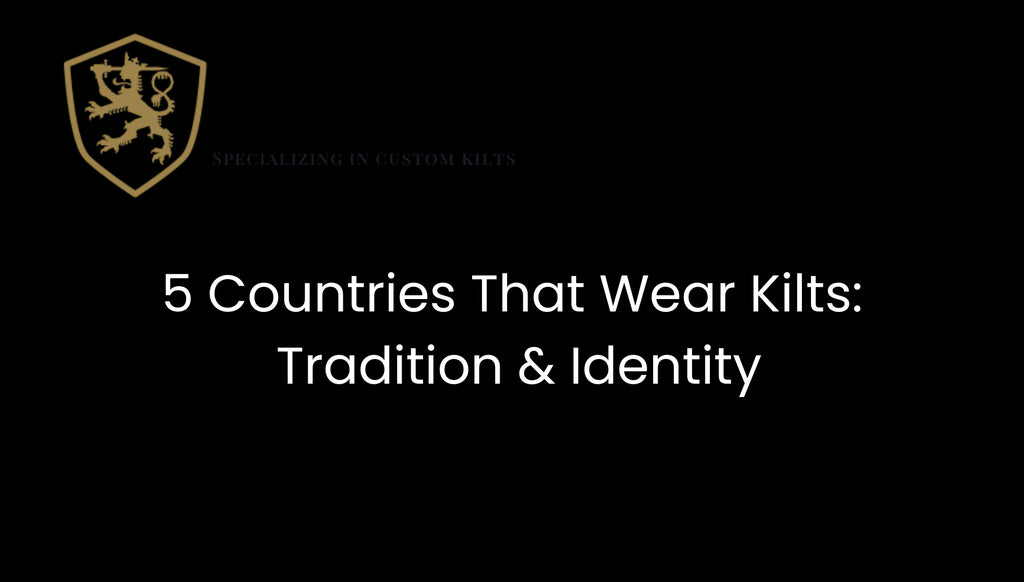5 Countries That Wear Kilts: Tradition & Identity
Posted by FAGENT ABRONT

The kilt, often associated with the rugged highlands of Scotland , is more than just a piece of clothing. It is a symbol of cultural identity, steeped in history, and worn with pride by various nations across the globe. While Scotland may be its birthplace, the kilt's influence extends far beyond, finding a place in the traditions and celebrations of countries like Ireland, Wales, and even parts of Canada. This article delves into the rich history of kilts, their significance in different cultures, and how they have evolved into a global symbol of heritage and pride.
Origins and Evolution
The kilt's history dates back to the 16th century, originating in Scotland as a garment designed for the rugged terrain and harsh climate. Initially, it was a full-length garment called the "great kilt" ,which provided warmth and versatility to its wearer. Over time, the kilt evolved into the shorter, more tailored version we recognize today, reflecting changes in fashion, social norms, and practicality.
Cultural Adoption
While Scotland is the heartland of the kilt, its adoption by other cultures highlights its versatility and symbolic power. In Ireland and Wales, kilts have been embraced as part of national dress, each with its unique styles and tartans. This cross-cultural adoption underscores the kilt's role in celebrating Celtic heritage and identity.
Countries that Wear Kilts
Kilts, while often associated with Scotland, are worn in various countries around the world, each adding its unique touch to this traditional garment. The kilt's versatility and symbolic significance have allowed it to transcend its Scottish origins, becoming a symbol of heritage, celebration, and even fashion in multiple cultures. Let's explore the countries that have embraced kilts and how they integrate this attire into their cultural and ceremonial practices.
Scotland
Scotland is the heartland of the kilt, where it is deeply embedded in the nation's culture and history. Originally, the kilt was part of the Gaelic men's traditional dress, evolving from the "great kilt" or "feileadh mòr" in the 16th century to the tailored version we know today. Scottish kilts are renowned for their tartan patterns, each representing different clans and families, symbolizing loyalty and heritage. They are worn at formal events, weddings, Highland games, and other national celebrations.
Ireland
Ireland, with its close cultural ties to Scotland, also has a tradition of kilt-wearing, though it's less widespread. Irish kilts usually feature solid colors or specific tartans associated with Irish counties, rather than the clan-based tartans of Scotland. The kilt is a significant part of Irish national dress, particularly in bagpipe bands and during cultural events celebrating Gaelic heritage.
Wales
In Wales, the kilt is a symbol of national pride and is often worn to celebrate Welsh culture and identity, especially on St. David's Day. Welsh kilts might not be as globally recognized as their Scottish counterparts, but they carry similar regional and familial significance, featuring tartans that represent Welsh clans and families.
Canada
Canada, with its strong Scottish and Irish immigrant influences, has embraced the kilt as part of its multicultural heritage. Kilts are worn by Canadians of Celtic descent during weddings, parades, and Highland games. Canadian regiments in the military also wear kilts as part of their ceremonial dress, showcasing tartans that reflect their regimental or national heritage.
United States
In the United States, kilts have found popularity among people of Scottish and Irish descent, as well as with enthusiasts of Celtic festivals and Highland games. American kilts often feature traditional tartans, but there's also a trend towards contemporary designs and utility kilts, reflecting America's diverse and inclusive culture.
Other Countries
Kilts have also made their way into the ceremonial dress of countries with no direct historical connection to Scotland or Ireland. For example, in some African nations, kilts are worn as part of traditional attire in ceremonies or dances, incorporating local fabrics and designs. Similarly, countries with Celtic cultural festivals often see participants donning kilts as a nod to the shared heritage of Celtic nations.
Kilts embody a rich history and cultural significance that extends far beyond their Scottish roots. They are a testament to the enduring power of traditional attire to convey identity, heritage, and pride. As they continue to be adopted and adapted by cultures around the world, kilts remain a vibrant symbol of the interconnectedness of tradition and modernity. In embracing the kilt, we celebrate not only the fabric of the garment but the fabric of our shared human history.
